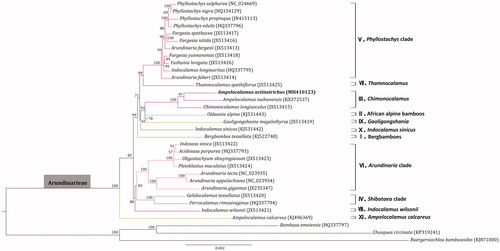Abstract
Ampelocalamus actinotrichus is one important ornamental bamboo endemic to China. In this study we produced the complete chloroplast (cp) genome of A. actinotrichus by genome-skimming method. The assembled cp genome is 139,754 base-pairs (bp) in length, with one large single copy region of 83,258 bp and one small single copy region of 12,856 bp separated by two inverted repeats of 21,820 bp. The genome contains a total of 129 genes, including 82 protein-coding genes, 8 ribosomal RNAs and 39 transfer RNAs. Phylogenomic inference robustly placed A. actinotrichus in the Chimonocalamus lineage (III), sister to A. naibunensis within Arundinarieae.
Ampelocalamus actinotrichus (Merrill & Chun) S.L. Chen T.H. Wen & G.Y. Sheng is a valuable ornamental bamboo for its apically drooping appearance in the family Poaceae (Bambusoideae) (Li et al. Citation2006). This species is endemic to southern China and plays a key role in understanding the intriguing continent-island disjunct distribution of Ampelocalamus (Wu et al. Citation2010; Zhang et al. Citation2016a). To date the genetic data of A. actinotrichus are very scarce (Zhang et al. Citation2016b). In this study we produced the complete chloroplast (cp) genome of A. actinotrichus by genome-skimming sequencing method (Zhang and Chen Citation2016), which will facilitate molecular biogeography studies on this ecologically important bamboo.
Total genomic DNA was extracted from new leaves of A. actinotrichus grown in Kunming Botanic Garden in Kunming, Yunnan province of China. The voucher specimen was deposited at the Tree Herbarium of Northwest A&F University (accession number ZXZ151201). Illumina paired-end (PE) library was prepared and sequenced in Beijing Genomics Institute (BGI) in Shenzhen, China. The cp genome was assembled via CLC Genomics Workbench v7.5 (CLC Bio, Aarhus, Denmark), as conducted in previous studies (Wang et al. Citation2018). The finished cp genome was annotated by DOGMA (Wyman et al. Citation2004), coupled with manual check and adjustment.
The assembled cp genome of A. actinotrichus (GenBank accession MH410123) is 139,754 base-pairs (bp) in length with high coverage (mean 340×), showing a typical quadripartite structure: one large single copy region (LSC) of 83,258 bp and one small single copy region (SSC) of 12,856 bp separated by two inverted repeats (IRs) of 21,820 bp. There are a total of 129 genes in the cp genome, including 82 protein-coding genes, 8 ribosomal RNA (rRNA) genes and 39 transfer RNA (tRNA) genes. Nine protein-coding genes (atpF, ndhA, ndhB, petB, petD, rpl16, rpl2, rps12, rps16) have one intron each and one gene (ycf3) contains two introns. Protein-coding regions (CDS) contribute 42.5% of A. actinotrichus cp genome and the overall GC content of this cp genome is 38.9%. In all, the A. actinotrichus cp genome shows a highly conserved genome structure of temperate woody bamboos (Arundinarieae) (Zhang et al. Citation2011).
Phylogenomic analysis was conducted upon 33 bamboo cp genomes using RAxML v.8.2.8 (Stamatakis Citation2014). The resulted maximum likelihood (ML) tree revealed that A. actinotrichus clustered in the Chimonocalamus clade (III), sister to a species endemic to Taiwan Island that is, A. naibunensis with high-support value (). The phylogenetic relationships among the 11 major lineages (I to XI) of Arundinarieae shown here are congruent with recent studies (Ma et al. Citation2014; Zhang and Chen Citation2016). The internodes between these lineages in the ML tree are short, implying a recent radiation (Zhang et al. Citation2016b).
Acknowledgements
The authors thank Yuxiao Zhang for the help in sample collection.
Disclosure statement
The authors report no conflicts of interest. The authors alone are responsible for the content and writing of this article.
Additional information
Funding
References
- Li DZ, Wang ZP, Zhu ZD, Xia NH, Jia LZ, Guo ZH, Yang GY, Stapleton CMA. 2006. Bambuseae (Poaceae). In: Wu ZY, Raven PH, Hong DY, editors. Flora of China, Vol. 22. Beijing and St. Louis: Science Press and Missouri Botanical Garden Press; p. 99–102.
- Ma PF, Zhang YX, Zeng CX, Guo ZH, Li DZ. 2014. Chloroplast phylogenomic analyses resolve deep-level relationships of an intractable bamboo tribe Arundinarieae (Poaceae). Syst Biol. 63:933–950.
- Stamatakis A. 2014. RAxML version 8: a tool for phylogenetic analysis and post-analysis of large phylogenies. Bioinformatics. 30:1312–1313.
- Wang WC, Chen SY, Zhang XZ. 2018. Whole-genome comparison reveals divergent IR borders and mutation hotspots in chloroplast genomes of herbaceous bamboos (Bambusoideae: Olyreae). Molecules. 23:1537.
- Wu ZY, Sun H, Zhou ZK, Li DZ, Peng H. 2010. Floristics of seed plants from China. Beijing: Science Press.
- Wyman SK, Jansen RK, Boore JL. 2004. Automatic annotation of organellar genomes with DOGMA. Bioinformatics. 20:3252–3255.
- Zhang XZ, Chen SY. 2016. Genome skimming reveals the complete chloroplast genome of Ampelocalamus naibunensis (Poaceae: Bambusoideae: Arundinarieae) with phylogenomic implication. Mitochondrial DNA Part B. 1:635–637.
- Zhang YJ, Ma PF, Li DZ. 2011. High-throughput sequencing of six bamboo chloroplast genomes: phylogenetic implications for temperate woody bamboos (Poaceae: Bambusoideae). PLoS One. 6:e20596.
- Zhang YX, Ye XY, Yang HM, Zhang XZ, Wang PY, Li DZ. 2016a. New distribution records of two bamboo species in Yunnan, China with description of the inflorescence for Melocalamus yunnanensis (Poaceae, Bambusoideae). PhytoKeys. 62:41–56.
- Zhang XZ, Zeng CX, Ma PF, Haevermans T, Zhang YX, Zhang LN, Guo ZH, Li DZ. 2016b. Multi-locus plastid phylogenetic biogeography supports the Asian hypothesis of the temperate woody bamboos (Poaceae: Bambusoideae). Mol Phylogenet Evol. 96:118–129.

